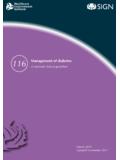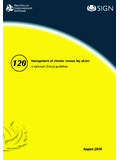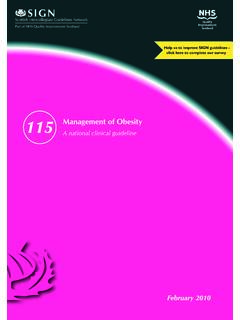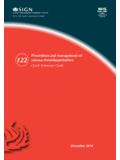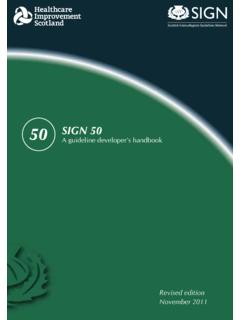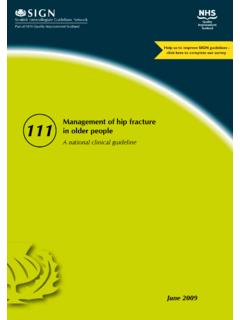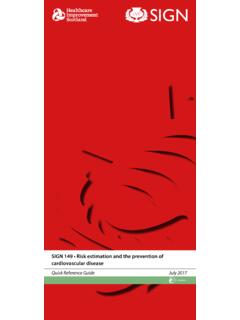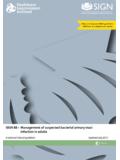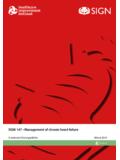Transcription of SIGN 139 • Care of deteriorating patients
1 SIGN 139 Care of deteriorating patientsConsensus recommendationsMay 2014 EvidenceScottish Intercollegiate guidelines NetworkCare of deteriorating patientsConsensus recommendations May 2014 Care of deteriorating patientsScottish Intercollegiate guidelines Network Gyle Square, 1 South Gyle Crescent Edinburgh EH12 published May 2014 ISBN 978 1 909103 26 9 Citation textScottish Intercollegiate guidelines Network (SIGN). Care of deteriorating patients . Edinburgh: SIGN; 2014. (SIGN publication ). [May 2014]. Available from URL: consents to the photocopying of this guideline for the purpose of implementation in Introduction .. The need for guidance .. Remit .. Statement of intent .. Review and updating ..12 Recommendations .. Observation .. National Early Warning Score .. Sepsis .. Limited reversibility.
2 Graded response .. Communication .. Data collection ..43 Implementing the recommendations .. Implementation strategy .. Resource implications of recommendations .. Auditing current practice ..54 The consensus methodology .. The Delphi process .. The consensus group .. Acknowledgements .. Editorial review ..8 Abbreviations ..9 Annexes .. of deteriorating patientsContents8 |Care of deteriorating patients | 1 Care of deteriorating patients1 Introduction1 THE NEED FOR GUIDANCEThe Scottish Patient Safety Programme (SPSP) is co-ordinated by Healthcare Improvement Scotland. Over the last five years the SPSP has supported improved processes of care, including recognition of deterioration in patients , by implementation of Early Warning Score (EWS) June 2012, the Cabinet Secretary for Health and Wellbeing set new aims for acute adult health care in NHSS cotland including a 20% reduction in Hospital Standardised Mortality Ratios (HSMR) and that 95% of patients should be free from avoidable harm.
3 While considerable gains have been made in improved processes to recognise and deliver appropriate treatment to deteriorating patients , there is much work to be done to implement reliable systems across Scottish Intercollegiate guidelines Network (SIGN) has developed these consensus recommendations to underpin a national approach to care of adult deteriorating patients . They set out the essential elements for prompt and reliable recognition of and appropriate response to deteriorating patients in Scotland s acute healthcare OVERALL OBJECTIVESThis document provides consensus recommendations based on expert opinion for best practice in the management of deteriorating adult patients . The recommendations are intended to guide NHSS cotland boards, hospitals and health professionals in the development of local systems that will deliver reliable recognition and response to the deteriorating patients in their POTENTIAL USERSThis document will be of interest to healthcare professionals involved in the care of deteriorating adult patients , their families and service STATEMENT OF INTENTThis statement is intended to describe an appropriate level of response to any adult patient who suffers physiological deterioration in an acute hospital setting.
4 It is not based on evidence but on the consensus opinion of a clinical expert group and is not intended to be construed or to serve as a standard of care. Standards of care are determined on the basis of all clinical data available for an individual case and are subject to change as scientific knowledge and technology advance and patterns of care evolve. Adherence to recommendations will not ensure a successful outcome in every case, nor should they be construed as including all proper methods of care or excluding other acceptable methods of care aimed at the same results. The ultimate judgement must be made by the appropriate healthcare professional(s) responsible for clinical decisions regarding a particular clinical procedure or treatment plan. This judgement should only be arrived at following discussion of the options with the patient, covering the diagnostic and treatment choices available.
5 It is advised, however, that significant departures from the national consensus statement or any local guidelines derived from it should be fully documented in the patient s case notes at the time the relevant decision is REVIEW AND UPDATINGT hese recommendations were issued in 2014 and will be considered for review in two years. Any updates to the recommendations in the interim period will be noted on the SIGN website: of deteriorating patients2 |2 RecommendationsIn order to support a national approach to the care of deteriorating adult patients across Scotland a group of clinical experts (see section ) took part in a modified Delphi process (see section ) to establish good -practice recommendations. These recommendations should be adopted as an appropriate response in the care of deteriorating adult patients in an acute hospital setting by NHS boards in Scotland.
6 These recommendations are based on guidance from the National Institute for Health and Care Excellence (NICE),1 the Royal College of Physicians2 and the South Australian The recommendations do not appear in order of OBSERVATION1 Physiological observations should be recorded at the time of admission or initial A clear written monitoring plan should specify which physiological observations should be taken and how Observations should be performed by staff trained to undertake these procedures and who understand their clinical Regular assessment of staff taking observations should be undertaken, to defined competency As a minimum, observations should include: yheart rate yrespiratory rate yblood pressure ylevel of consciousness yoxygen saturation including percentage/flow rate of administered oxygen therapy ytemperature ystate of hydration (for patients with medium or high NEWS score).
7 6 In specific situations additional monitoring will be required, eg biochemical analysis, (such as blood glucose or lactate) or pain NATIONAL EARLY WARNING SCORE7 Acute hospitals should implement the National Early Warning Score (NEWS).28 NEWS should be used to monitor all adult patients in acute hospital settings. Maternity specific EWS should be used for pregnant NEWS should be monitored at least every four hours after admission to hospital unless a decision is made and documented at a senior level to decrease the frequency of monitoring for an individual The frequency of monitoring should increase if abnormal physiology is A protocol which defines increased frequency of observations for patients whose NEWS score triggers action should be implemented and its compliance Any patient whose NEWS score triggers action should be screened for sepsis and of deteriorating patients | 32 SEPSIS13 All patients who screen positively for sepsis should be started on the Sepsis Six care pathway,4 unless their treatment plan indicates Six (within one hour).
8 Ydeliver O2 (94 98% SpO2 or 88 92% in patients with chronic obstructive pulmonary disease) ytake blood cultures and consider source control ygive intravenous (IV) antibiotics according to local protocols ystart IV fluid resuscitation (minimum 500 ml) and reassess ycheck lactate and full blood count ycommence accurate urine output measurement and consider urinary LIMITED REVERSIBILITY 14 A process should be in place to identify patients with limited reversibility. patients identified as deteriorating with limited reversibility should have a written management plan which considers and includes: ykey issues yanticipated outcomes which acknowledge uncertainty yresuscitation status ydiscussions with the multidisciplinary team y discussion with the patient and family, which may include discussion of uncertain recovery and medical plan, preferred place of care and concerns or wishes ystandardised and agreed ceilings of GRADED RESPONSE 15 A graded response for patients identified as deteriorating should be agreed, implemented and audited example.
9 Low NEWS score yincrease the frequency of observations and alert the nurse in NEWS score yrespond within 30 minutes ymake an urgent call to the team with primary medical responsibility for the patient yalso call the person with core competencies for acute NEWS score yrespond immediately y make an emergency call to the team with critical care competencies and diagnostic patients with a medium or high NEWS score should have: yappropriate interventions initiated y the response to these interventions assessed at the time of the intervention or at a later time ya written management plan that includes location and level of of deteriorating patients4 | COMMUNICATION17 All communication about patients identified as deteriorating should be formalised and include: y a daily process for person-centred communication that includes the wishes of the patient and family ya structured handover process which includes all relevant clinical DATA COLLECTION18 Acute hospitals should collect data on a monthly basis that measures the number and rate of cardiac arrests (with chest compressions and/or defibrillation).
10 19 Acute hospitals should consider the introduction of electronic track, trigger and alert of deteriorating patients | 53 Implementing the IMPLEMENTATION STRATEGYI mplementation of these consensus recommendations is the responsibility of each NHS board and is an essential part of clinical governance. Mechanisms should be in place to review care provided against the recommendations. The reasons for any differences should be assessed and addressed where appropriate. Local arrangements should then be made to implement the recommendations in individual hospitals, units and of these recommendations will be encouraged and supported by Healthcare Improvement Scotland. The national implementation strategy for these consensus recommendations includes the Acute Adult Scottish Patient Safety Programme which will support NHS boards to test and implement processes to provide a structured response and review for deteriorating RESOURCE IMPLICATIONS OF RECOMMENDATIONST raining: there will be a requirement to ensure adequate training for healthcare workers in the detection of and response to deteriorating patients , as well as monitoring continuing : there will be a requirement to ensure adequate levels of appropriately qualified staff to detect and respond to deteriorating Early Warning Score: implementation of a National Early Warning Score is a desired future state for acute adult care in track, trigger and alert systems.
